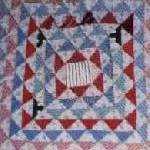America's Quilting History
Pieced Quilts: An All-time Favorite

It wasn't until around 1850 when the manufacture of textiles had moved to being factory based that quilting became widespread. Ordinary women no longer had to spend hours a day spinning and weaving. At last they could find the time to be more creative including the making of quilts. Once quilting was available to almost everyone pieced quilting became widespread. This most popular form of quilting ranges from simple patterns that can be quickly made for everyday use to intricate works of art.
We take it for granted today that we can easily find quilt patterns in books, magazines and even online. Although a few patterns were published in early America and more by the late 1800s women of the 19th and the early 20th centuries had another way to share and remember favorite block patterns.
When stacks of blocks are found at an estate sale or in the attic of an old house we tend to think they were pieced to be sewn together into a sampler quilt. This wasn't always the case. These blocks might have been made up as a way to remember quilt patterns that friends have shared. Sometimes the blocks in such a collection appear to have been quickly dashed together to just give the woman an idea of how the pattern went. Others were more carefully stitched. These sets of pattern blocks ranged from just a few blocks to dozens of them. Collections of these cloth patterns have been found bundled together with string, stored in a box or even connected with a thread through them as if they were a book or album. A few women carefully labeled each block with its name and credit to the friend who shared it. Many were left without documentation. Then, like now, women tended to think of history as something from long ago without realizing what they did would become a part of a future history.

Sometimes these blocks were sewn together in what we now call a pattern quilt because it is made up of blocks originally made to be used as patterns. Occasionally these might have been sewn together during the lifetime of the quilter who had made the blocks but often they were sewn together years later. The pictured quilt contains fabric and blocks dating from 1842 - 1940s. Thanks to quilt historian, Karen Alexander, for permission to include this fascinating quilt on this page. If you wish to reproduce this picture for any purpose be sure to first ask Karen Alexander by writing to KareQuilt@aol.com.
Imagine you are a farm wife isolated by both distance and long hours of work. What could be more fun than to visit a neighbor and look over her collection of sample blocks? The blocks might inspire a chat about the quilts already made or plans for future quilting. Some neighborly gossip might be triggered by the fabric or blocks. How exciting it would be if one of the blocks was a brand new pattern. Perhaps it was designed by the maker or a pattern that had just become the rage in the city, sketched in a letter by a relative from the east. Even after published patterns were commonly available sharing patterns neighbor to neighbor and grandmother to granddaughter continued.
A few quilt patterns were published in magazines as early as 1835 but they became more common by the mid 19th century. Magazines including Godey's Lady's Book attempted to interest women in the more refined English patchwork and recommended the use of silk. Apparently this only influenced a few quilters as most American women preferred the same quilt designs that their friends and relatives used.
Magazines could even convey political leanings as did Peterson's magazine when it published a stars and stripes pattern. The inclusion of stars for all the states in a quilt pattern published at the beginning of the Civil War indicated definite Union sentiments.

It was not until the late 1800s that those familiar patterns American women loved most began to appear in print. Farm magazines discovered that printing quilt patterns was a great attraction to woman readers. Other magazines soon followed. Even newspapers got on the bandwagon and published quilt patterns.
By 1890 catalogue sales included quilt patterns. If a woman ordered her yard goods from Sears or Wards she could purchase any of 800 designs for just a dime. Another catalogue source was "Diagrams of a Quilt, Sofa and Pincushion Patterns" published by Ladies Art. The tradition of women sharing fabric sample blocks with other women took a new twist. Ladies Art offered full sized blocks in either calico or silk to be used as patterns. The price ranged from one to three dollars.
By the beginning of the 1900s magazines went a step beyond publishing patterns. Some had a column where readers could share favorite patterns and even new ones they had designed. Many offered mail order patterns as well.
Quilters were no longer restricted to only quilt patterns known in their region. From bustling city to lonely farmhouse women could be making the same quilt.
© 2001 Anne Johnson (Do not reproduce any material from this site without permission.)References:
"Clues in the Calico" by Barbara Brackman
"Quiltmaking in America: Beyond the Myths" by Laurel Horton (Editor)
Especially the article, "Quilt Blocks - Or Quilt Patterns" by Wilene Smith (pp 30 - 39)

